Snowshoeing the Cabinets
4 Snowshoe Treks in the Cabinet Mountains
The thermometer read -2 degrees at the trailhead to the Ross Creek Cedars Scenic Area in western Montana.
But three miles later and a thousand feet higher, among the scenic area’s namesake cedars, it was a full 10 degrees colder, the product of a moisture-trapping canyon that no doubt nursed these trees’ gargantuan growth. My wife, sister, and I, who had all snowshoed to the grove that New Year’s Eve, struggled to suck in breaths of frigid air. But if the cold hadn’t left us speechless, the trees would have: massive western redcedars up to eight feet in diameter and 175 feet tall — big enough to stand up inside their heart-rotted trunks. A campfire that night at the historic Bull River Guard Station slowly melted the chill of that cedar grove, but the awe of the place stayed in our bones.

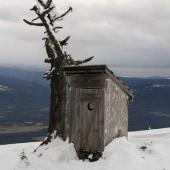

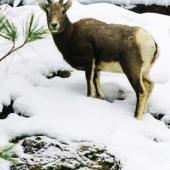
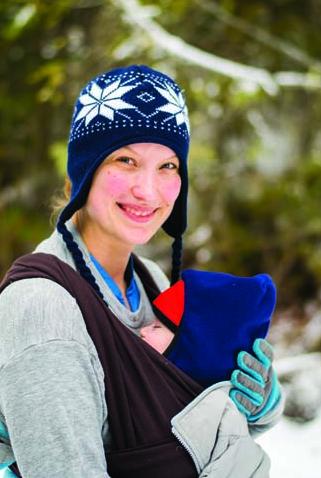
When French-Canadian fur trappers first surveyed the mountain range straddling the Idaho/Montana border just this side of Canada, they dubbed it the Cabinet Mountains, for the sheer shelves of rock that loomed over the rivers below. In the intervening 200 years, the snowshoe technology used to cross the Cabinets may have changed, but little else has. The Cabinet Mountains Wilderness protects almost 100,000 acres of subalpine lakes and knife-edge peaks in the heart of the range; separated from the wilderness by two-lane state Highway 56. The Scotchman Peaks Wilderness Study Area still needs an act of Congress to protect its 88,000 acres of rugged ridgelines and steep, brushy drainages.
Thanks to a maritime-influenced climate, the Cabinets boast abundant precipitation; some Sno-Tel sites in the range routinely register the highest snowpack in Montana. Deep powder, coupled with trails easily accessed from the surrounding Kootenai, Clark Fork, and Bull River valleys, rate the Cabinets as one of the region’s wildest winter destinations.
Here are four snowshoe treks that introduce winter adventurers to the Cabinet Mountains.
1) Tucked in a moisture-trapping creek drainage high above the Bull River valley on the east side of the Scotchman Peaks, the Ross Creek Cedars Scenic Area shelters some truly astonishing tree specimens. A 0.9-mile interpretive trail winds around and under some of Montana’s largest, oldest trees. In the winter, snowshoe the three-mile access road to access the cathedral-quiet grove. Stand in awe of snow-covered cedars that attained old-growth status well before Columbus spied the Americas. A viewpoint halfway up the road caps continuous climbing with views of Snowshoe and A Peaks and the Ibex Creek drainage of the Cabinet Mountains Wilderness.
Directions: From Troy, Montana., drive east 2 miles on Highway 2. Turn right on Highway 56, and drive 18 miles to Ross Creek Road (FS Road 398). Turn right and drive 1 mile to the winter parking area.
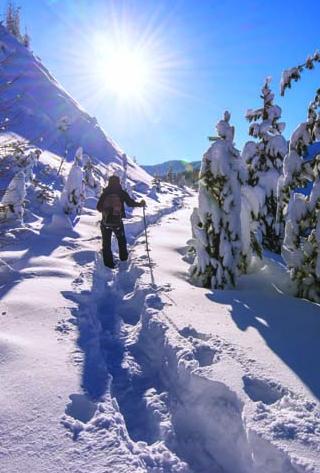
2) When it was constructed a century ago, Old Highway 2 was considered to be the most spectacular piece of auto road construction in the western United States. Linking Glacier National Park with northwest Montana, the narrow, winding highway stayed high above the Kootenai River, where work crews had blasted it out of the talus slopes of the Cabinets. Today, a modern highway zips cars along the banks of the Kootenai, but travelers interested in a slower pace — and a slice of history — will find much to enjoy on the old highway, now a non-motorized trail. Several trailheads access the old highway; from its west end closest to Troy, the old highway passes the trail to William Grambauer Mountain — a short, steep spur trail to shallow Shannon Lake 0.2 mile from the west trailhead is best left for the summer — before ascending a slight hump and then descending to the “new” Highway 2 2.3 miles later. Snowshoers not keen on a 4.6-mile trip can trek to the halfway point for a bird’s-eye view of Kootenai Falls. Marvel at the powerful cascades far below; close at hand, admire the engineering work — and sheer brute force — required to blast this road out of the bedrock.
Directions: From Troy, drive east 2 miles on Highway 2. Turn right on Highway 56 and drive 1.7 miles to Shannon Lake Road. Turn left and drive 1.5 miles to the road’s end and trailhead.
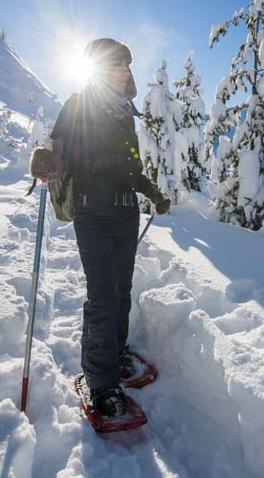
3) The recently restored historic trail to Star Peak (aka Squaw Peak; the old appellation still appears in some maps and guidebooks), in the Scotchman Peaks- proposed wilderness area of the western Cabinets, isn’t any easier than its predecessor. It still gains about 4,000 feet of elevation in four relentless miles, but it’s more visually appealing. And the destination still looks as grand as ever. Although the peak barely lunges past the 6,000-foot mark, it’s high on vertical relief; Idaho’s Lake Pend Oreille and its tributaries are almost directly beneath, over 4,000 feet below. From the active fire lookout on its summit, the peak boasts 360-degree views of the Bull River Valley, Lake Pend Oreille, and the two highest peaks in the Cabinet Mountains Wilderness, A Peak and Snowshoe Peak. Just below the lookout sits a century-old rock shelter and one of the best lee views in the region. From its trailhead on Highway 200 just west of Heron, the historic Star Peak trail — one of five that gains the summit of Star Peak — climbs 4,000 feet in 4.1 miles; it’s not the steepest trail in the region, but it’s close enough. However, because it’s in the trees until just short of the top, the trail to Star Peak is relatively protected from avalanches. Pitch a four-season tent in the lee of the rock shelter for one of the region’s best winter-camping experiences.
Directions: From Heron, drive west on Highway 200 2 miles to an unmarked, steeply ascending jeep road on the right side of the highway, directly opposite a large pullout. Park in the pullout, cross the highway, and ascend the jeep road .3 miles to the trailhead.
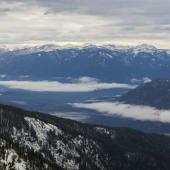
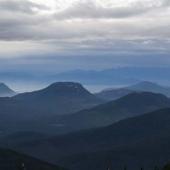
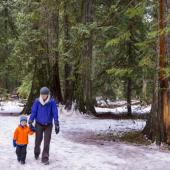
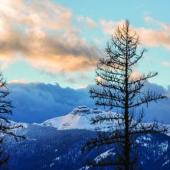
4) Snowshoe to a lookout with next-door-neighbor views of the interior of the Cabinet Mountains Wilderness on the 10-mile round-trip trek to Berray Mountain. Located outside the boundaries of both the wilderness and the Scotchmans, Berray boasts great views of both. The lower portion of the Berray Mountain trail winds its way through ponderosa pines and Douglas firs en route to scattered subalpine meadows on the summit. Periodic openings in the canopy peek into the Scotchman’s Pillick Ridge and Star Peak, nice rewards for snowshoers looking for a trek shorter than 10 miles. Close at hand, keep a keen eye out for bighorn sheep: Berray Mountain is home to a herd of about a hundred, which like to congregate near the base of the mountain in the winter and lick the salt-based de-icer off Highway 56.
Directions: From Noxon, drive 5 miles west on Highway 200. Turn right onto Highway 56 and drive 8 miles to Bull River Road. Turn right and drive 1 mile to the Berray Mountain trailhead, on the left side of the road.
For a unique base for exploration of the west side of the Cabinets, rent the historic Bull River Guard Station near Noxon. Built in 1908 by Granville “Granny” Gordon, the first District Ranger on the Cabinet National Forest (now the Kootenai National Forest), the guard station was used first as a home and office for Gordon and his family, then as a seasonal guard station. (Gordon also constructed the stone shelter at the summit of Star Peak.) Now the Forest Service rents out the guard station, which sleeps six and offers electric lights and appliances. In winter, the furnace will warm you up after trips to the outhouse; there’s no plumbing at the guard station.
The cabin is truly snowshoe-in/snowshoe-out; in winters with deep snowpack, guests may have to walk the last 1/8th mile to the cabin. Meanwhile, leisurely snowshoe walks abound on the forest roads surrounding the cabin, and the Berray Mountain trailhead lies a mile away.
* * * *
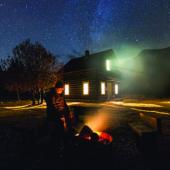
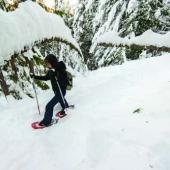

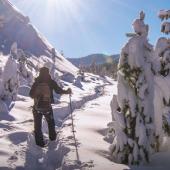
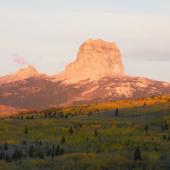

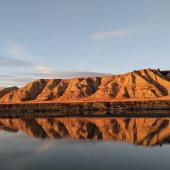



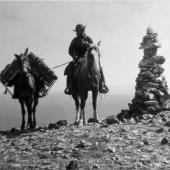





Leave a Comment Here